The Big Interview
‘History Is Waiting to Be Told’: Hank Willis Thomas on How Artists Can Reshape the Narrative of the United States in Real Time
The artist explains why his super PAC, For Freedoms, is also an artistic project.
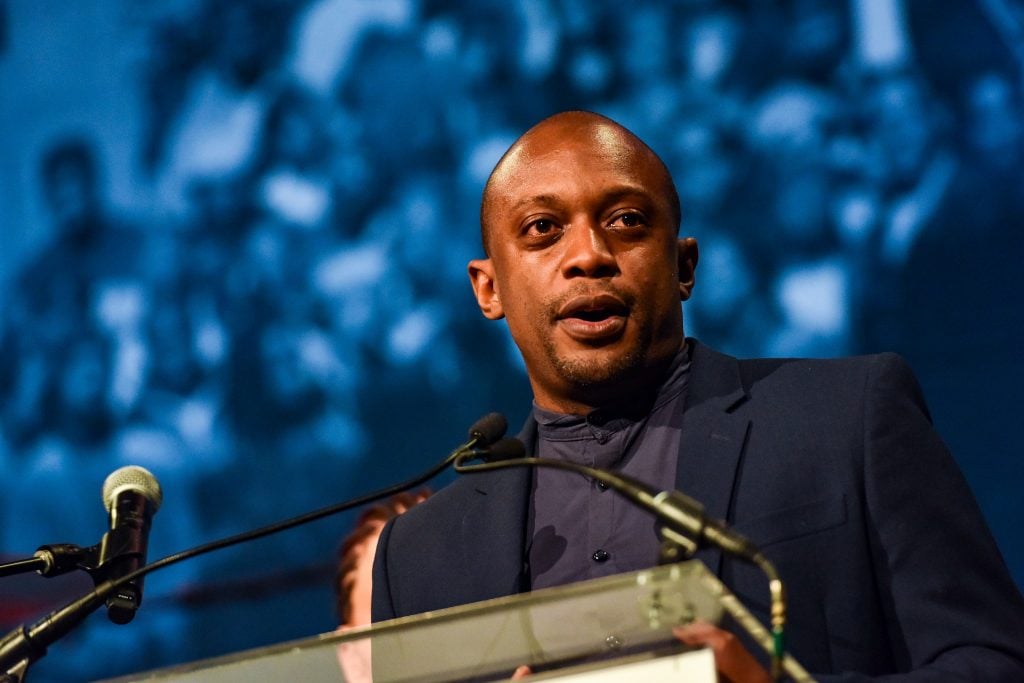
The artist explains why his super PAC, For Freedoms, is also an artistic project.

Andrew Goldstein

Hank Willis Thomas is a name many in the art world are familiar with, and not just because he is the son of lauded historian Deborah Willis (though that helps). Soon, a lot more people could become familiar with him and what he stands for.
The multimedia artist, who tackles some of the most difficult and complex issues of our time—systemic racism, marginalized communities, media bias, and income inequality, among others—is also the cofounder of For Freedoms, a super PAC turned nonprofit organization promoting civic engagement in the creative community.
Thomas once said that his personal experiences prompted him to create art that could “change the world in a more intentional way.” Now, more than ever, he is doing just that.
Through July 16, he and his Los Angeles gallery, Kayne Griffin Corcoran, are teaming up with Artnet Auctions to present “Bid for Peace,” a single-lot sale of Thomas’s striking sculpture, Peace, from 2019.
All proceeds from the auction, including the buyer’s premium, will be donated to Gays and Lesbians Living in a Transgender Society (G.L.I.T.S), a non-profit organization that protects the rights of transgender sex workers.
Thomas took some time out of his busy schedule to discuss the evolution of his studio practice, artists’ importance in bringing about civic transformation, and whether you might someday see his name on a ballot near you.
You can listen to a condensed version of this interview on Artnet News’s Art Angle podcast.
Before we get into what you’re up to now, let’s go back to where you come from. Tell me a little bit about your upbringing and how you became an artist.
Well, I think we’re all artists. I was born an artist and have over the past couple of decades really been in a process of discovering more and more what that can mean, every day.
And I do have the fortune of being the son of Deborah Willis, who’s an incredible person, as well as an art historian and photographer and photo historian. And I grew up at the Schomburg Center for Research in Black culture, where she worked, watching her discover and tell new narratives about American history, along with her colleagues and fellow artists and peers.
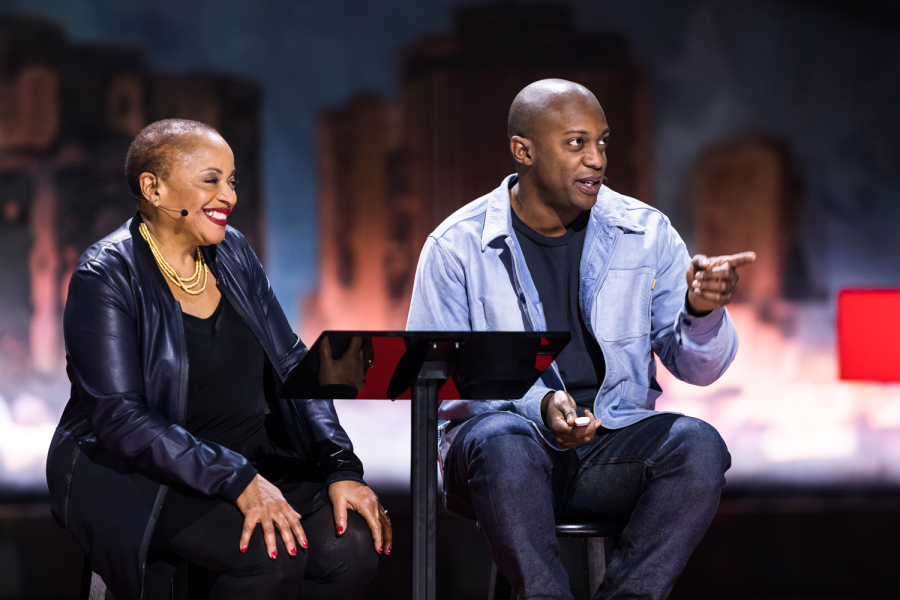
Deborah Willis and Hank Willis Thomas speak at TEDWomen 2017—New Orleans, Louisiana. Photo: Stacie McChesney / TED.
And so I think I learned the value of art through osmosis. I didn’t really appreciate it or respect it until I was about 30. And by that time I already had a BFA and an MFA. I thought that I was just asking questions and on my own path. And then I realized that was very much following in my mother’s footsteps as if she’d been pulling the puppet strings all along.
I remember I told my mother that I didn’t want to be an artist because all of her friends were broke… little did I know.
She won a MacArthur Grant in 2004 for her scholarship on photography and she is renown as a real force in the reconsideration of the tradition of African American photography and more broadly photography in America. What did she teach you about photography and how it intersects with the tangled story of this country?
I think the fundamental thing that I learned from my mother is that history is waiting to be told. Photography and the landscape of visual representation has always been a contentious space, especially for people who were from what we now call marginalized communities, communities that weren’t in control of the mainstream narrative. Nevertheless, there were people and will always be people who are part of these communities making images, taking photographs, and telling stories that are in stark contrast to the prevailing narratives, and are also much more accurate.
There’s another way your family history has shaped your work, in a far more tragic sense. Can you talk about your cousin Songha Willis?
Songha was my best friend, big brother, and mentor; my life plan was to be his backup singer. In February 2000, his mother went out of town so he went to Philadelphia, where he’d grown up, to look after my grandmother and see some friends from junior high school. They went to a night club and the friends he was with were robbed for some necklaces. The robbers had seen my cousin with them, but he didn’t have anything worth taking, so they made him lay face down in the snow and they shot him in the back of the head and killed him.
That was obviously a traumatic experience for me, it was also a life re-centering moment, because I literally had no plan or real dreams for my own life other than to be a part of his, so I had to discover who I was independent of my cousin.
I was really shocked, not only by the horror of the act, but also that the people who killed my cousin were young men, barely out of their teens, and now their lives were also over to an extent after they were caught. The history of our country has been tied to starving people into desperate circumstances where they partake in sometimes heinous acts as a means to feel relevant and important.
So a lot of my work has been in the spirit of reuniting us, collectively, with people from whom society has tried to alienate us, even ourselves.
You once said that after his passing you felt that you needed to make art that could change the world in a more intentional way. How did you go about constructing a path to do that?
I first started to look at the stories that were told and who was telling the stories in the media and beyond. I tried to find alternative methods of communicating ideas, one of the most popular ones being advertising. I realized advertising is the most ubiquitous form of communication in the modern world, and that it’s a language that can be translated across cultural boundaries because we’ve all become media literate. So I tried through various projects to use the language of advertising to talk about issues beyond what advertising was discussing.
One of your most powerful works, and one of the first times you chose to show something outside of a museum instead of inside, was with your MasterCard ad which you changed into a kind of retelling of your cousin’s story. Can you talk a bit about how you approached that particular image?
The name of the piece is Priceless and it consisted of a photograph of my cousins and a lot of my family members in a state of mourning. I used the language of the Mastercard “Priceless” campaign, where they would build up nostalgia about all these things you could do with your credit card like take your child to a baseball game, or get someone a gift. I said that “picking out the perfect casket for your son” was priceless.
I wanted to talk about how even in grief and mourning we’re still being marketed to, and all of the pomp and circumstance that we go through to prove the value of a life after its been taken.
One of your most famous photographs from the branded series was of a Black athlete’s head with the Nike swoosh literally, with a branding iron, seared onto his head. Just a little while ago you had a show at the Portland Museum of Art and you flew this image on a banner outside the museum, in the city where Nike is headquartered. What is it that draws you to sports, and in particular to the way that African American athletes exist in the sports world?
I think everyone has been conditioned to believe sports are important if only because they’re part of every nightly news broadcast alongside major weather reports and political events. A lot of the success or progress that was made for people who are traditionally marginalized is through sports.
The fact that sports is an opportunity for people to be seen as valuable is something we take for granted. There are many multibillion-dollar industries fueled by the labor of descendants of slaves.
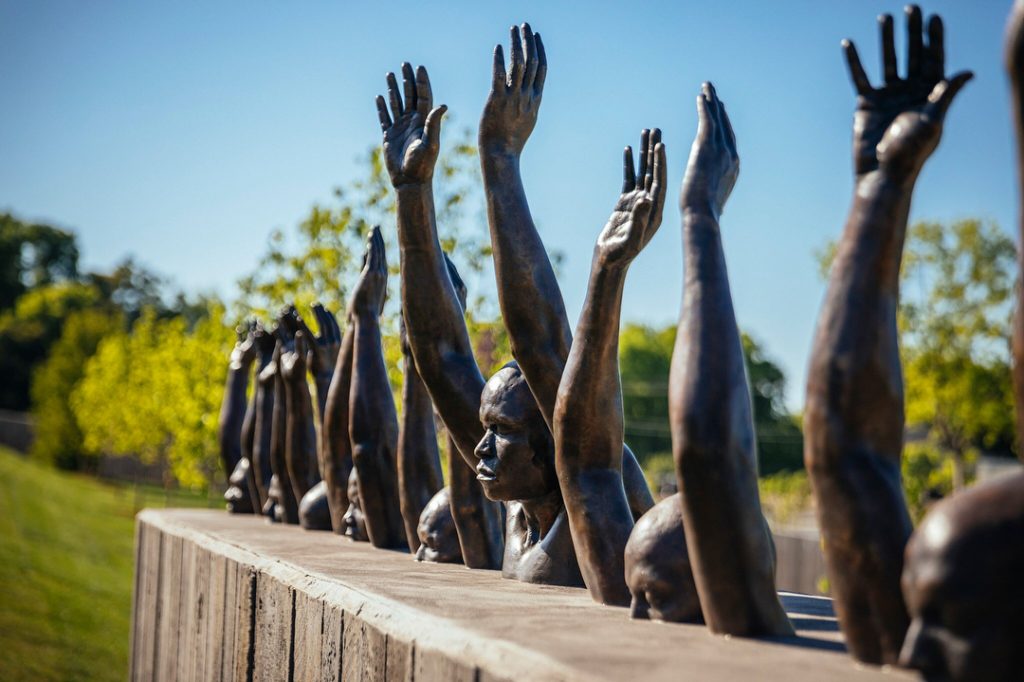
Hank Willis Thomas, Raise Up (2014). at The National Memorial for Peace and Justice. Courtesy Hank Willis Thomas.
As time went on you started to move from photography toward monumental sculpture. How did that transition take place?
Around 2003, I was living in the Bay Area of San Francisco and there was an uptick in homicides, especially in certain neighborhoods. I wanted to create a memorial because I had been in DC and seen all these memorials to fallen soldiers and to presidents, and I wanted to make work that really commemorated all of the other fallen soldiers, the fallen stars in our society who would not be appreciated for their contributions because they were civilians killed.
So I created a piece called Absolute Winning Seven for the victims of homicide in Oakland and San Francisco in 2004, made of bullets. I was really wanting to think about what it means to create monuments for people who aren’t seen as valuable or important or society.
One sculpture that really captures this of yours is Raise Up. What was the story behind that piece?
It was based off of a photograph by Ernest Cole, from in a book called House of Bondage that I found in South Africa, which was comprised of photographs that he smuggled out during apartheid, before the true horrors of apartheid had been revealed. The picture showed miners completely nude, facing a wall with their hands up; I’d always felt it was exploitative looking at the photograph, like I was in some way complicit, leaning in and gawking. I wanted to represent it in a way that was ethical, if it was possible. I created a sculpture based on that photograph, cropping it at the shoulders, and titled it Raise Up in February 2014.
I was really contemplating how a gesture of surrender could be interpreted as a gesture of resistance, and then in July, when Michael Brown was murdered in Ferguson, Missouri, and the call to action was “hands up, don’t shoot,” it had an incredible resonance with the work.
Many of us in the creative field know in our hearts that our work, at its best, lives outside of the space-time continuum, and can speak to the past as elegantly as it can to the future.
A co-curator of your show at the Portland Museum said, “We are often surprised by how his [Thomas’s] work dealing with race and bias becomes more and more relevant.”
I can relate to that. Oftentimes when I’ve made work, I thought I was being self-involved and stuck in the past, and then my eyes were opened—often in really harsh ways—that I was tapped into something deeper than I was even aware of when I started. That’s why I’m so fanatic about promoting other artists’ work because what we do in our studio is almost always the result of a research practice. I love the opportunity to promote the work of others because through their work, we see radical progression and the evolution of our society.
To round out the monument topic, you’re now working on a monument that shows Martin Luther King, Jr., and his wife, Coretta Scott King, embracing that will debut in the Boston Common in 2022. That is a decidedly uplifting image, but at the same time there is this movement across the country where monuments are being torn down. As an artist who’s creating this work, how are you experiencing this moment?
I’m experiencing it with a lot of enthusiasm, for the audacity of the people who are forcing us to do things that should have been done a long time ago. Public space belongs to the public and they should have a say in what kinds of images and objects represent the society.
It’s also important that things get reconsidered from time to time. Maybe once a century, at least, you have a reconsideration of all these monuments to men who are celebrated often as a way to put down and disrespect other people.
What do you think art can do when it comes to creating change?
Everyone who engages with art, whether they know it or not, is being changed and affected; the proof of that is that artists who were seen as radical 40 and 50 years ago for dealing with issues related to LGBTQ+ people, or multiculturism, or women’s rights, those are mainstream issues now.
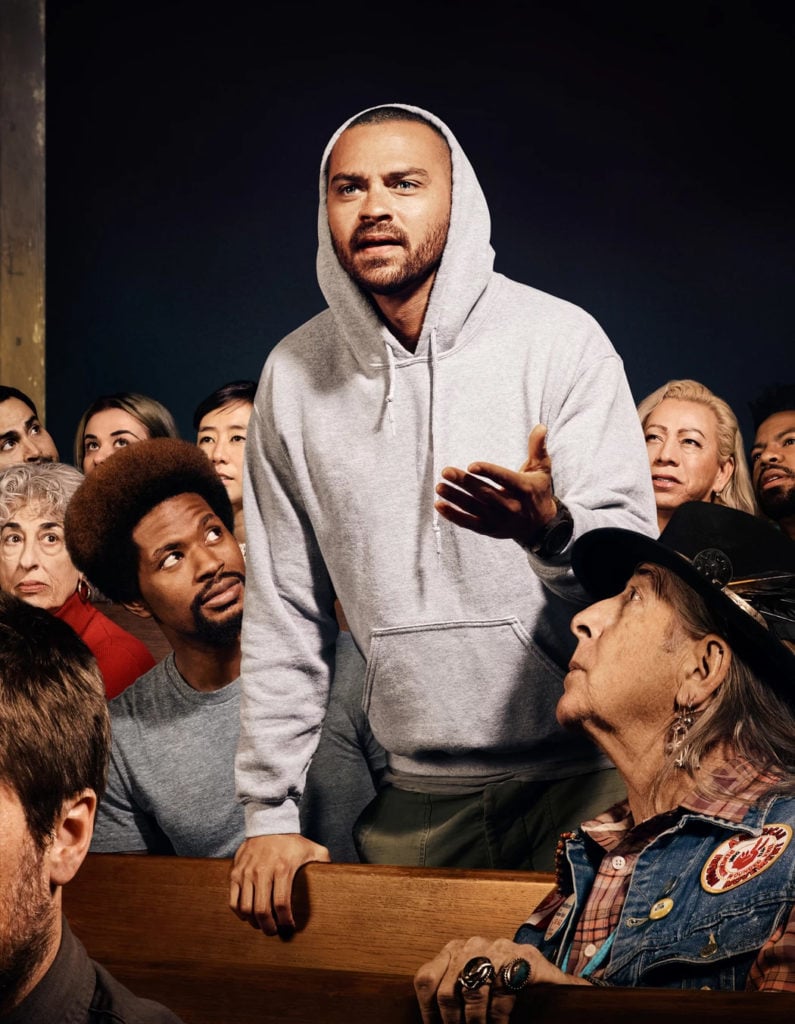
For Freedom’s interpretation of Norman Rockwell’s Freedom of Speech, featuring actor and activist Jesse Williams (standing). Photo courtesy of For Freedoms.
Let’s talk a bit about the non-art work you’re doing to change unjust institutions. What is the story behind your nonprofit For Freedoms, and why of all things, did you decide to create a Super PAC?
Well, it is still art. Have you ever thought about laws as conceptual art? The whole way we govern society is based around concepts, and I recognize that there are avowed non-creative people literally designing our society through the laws they create in the narratives they choose. By and large, members of the creative community don’t even have an opportunity to participate in those narratives, so then how could they ever shape or affect the laws? So my friends and I thought if we created this PAC to elevate the voices of artists as a form of political civic engagement, we could start the movement toward radically changing society.
We realized that there are institutions, museums, that have audiences in the millions and tens of millions who walk in with open minds to be challenged, and those institutions often don’t feel like they have the place to speak to the current moment politically or even at all. So we’ve started to do exhibitions and town halls and billboards to attract the attention of those people. We’re attempting to promote the critical work artists are doing by framing it as political speech, because we know that when you say something is “political” it implies there’s something at stake.
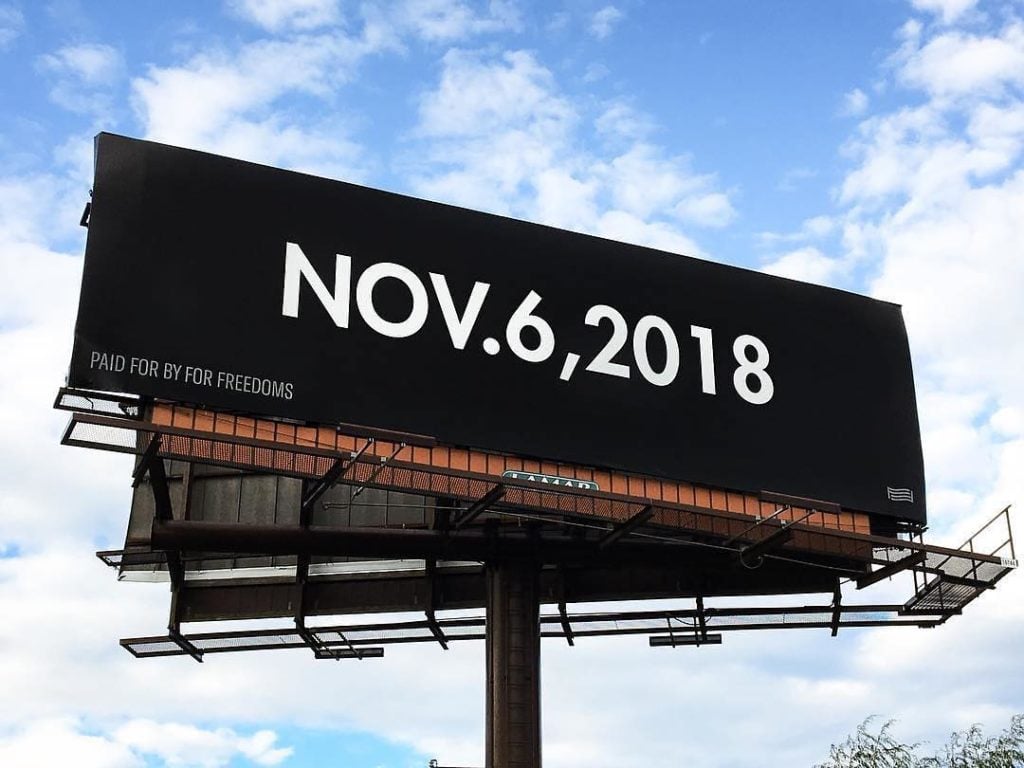
Trevor Paglen’s “Nov. 6, 2018” billboard in Hartford, CT. Photo via Instagram courtesy For Freedoms.
I realized back in 2008 when Barack Obama was elected, he was a relatively unknown person who used slogans like “hope” and “change” and that was really great branding to inspire people and earn the nation’s trust. The fact that these two relatively meaningless statements could be such radical tools for engagement and enthusiasm was kind of frightening to me, and I recognized it was no longer about money in politics, it was really about how you can tell the best story.
For Freedoms is an act of creative patriotism, and we hope that it will continue as a model for generations, because it’s terrible to see political discourse without critical discourse.
In the spring right before the coronavirus outbreak shut down the US, you staged a For Freedoms convention in Los Angeles. What happened there, and now that the stakes are higher than ever, how are your efforts changing in the run up to this election?
That was a great event. We brought 500 delegates and people from all 50 states plus DC and Puerto Rico to develop a creative plan of action around civic engagement, in an election year; and a week after we got home, my wife got sick with the coronavirus.
Wow.
The world changed forever, and the old rules we were engaging with had changed. We realized we needed to start playing a new game and the rules would need to be rewritten. With the protests now, it really harkens back to a moment of change around 1860 when a group of abolitionists came together across the nation to reimagine what society was possible. They were called the Wide Awakes, and they chose then-candidate Abraham Lincoln to support, and through these creative, non-violent performances that had singing, music, and graphic design elements, inspired a movement that pushed our country to a better place.
You shared a pretty gnomic Instagram post of an album cover for a band apparently called the Wide Awakes recently, that featured an inverted pyramid with an eye inscribed in it, and it piqued my interest, realizing as you said that Lincoln actually used the historical group as a “get out the vote” mechanism. Is this new Wide Awakes 2020, as you called it, going to be similarly involved?
We hope so! It depends on if you all join in. For Freedoms has always been anti-partisan because we recognize that the left-right binary doesn’t make space for the rest of us, it’s really through an unwillingness to think outside the box that we get trapped in tit-for-tat arguments rather than truly engaging with issues we care about.
Would you ever consider treading over the line from art and politics into solely politics?
I think anyone who cares at all should consider it. I would hope that I’m not the only artist who’s seriously considering it, and I will probably at some point try to run for some office. I’d rather my wife do that because I think there are so many women I know who would make much better leaders, but I would never want them to do something I wouldn’t be willing to do myself.
Is there anything that makes you really hopeful right now?
I feel hopeful because I have never known the world to be more mindful and more aware of every breath, and of the value of every breath and the necessity for us to speak up for what we truly believe in.